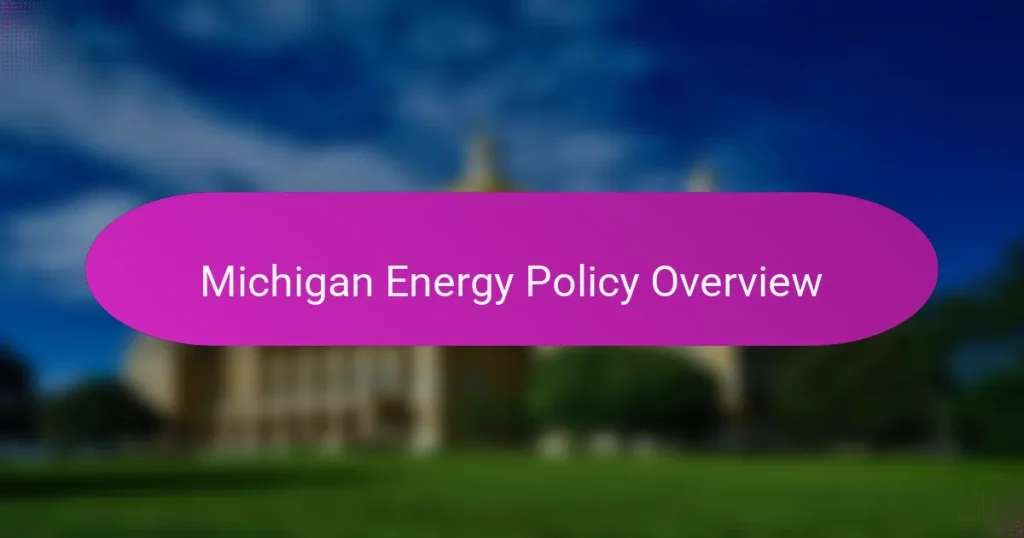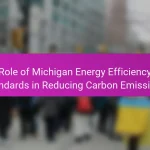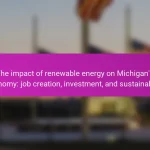
What is Michigan energy policy?
Michigan energy policy encompasses the strategies and regulations governing energy production, distribution, and consumption in the state. It aims to enhance energy efficiency, promote renewable energy sources, and ensure reliable energy access for residents. The policy encourages the development of clean energy technologies, such as wind and solar power. It also includes initiatives for reducing greenhouse gas emissions and improving energy infrastructure. The Michigan Public Service Commission oversees the implementation of these policies. In 2020, Michigan set a goal to achieve 50% renewable energy by 2030. The state also supports energy efficiency programs to lower consumer costs and reduce energy waste.
How has Michigan’s energy policy evolved over time?
Michigan’s energy policy has evolved significantly since the early 20th century. Initially, the focus was on expanding access to electricity and supporting industrial growth. In the 1970s, energy crises prompted a shift towards conservation and alternative energy sources. The state established the Michigan Public Service Commission to regulate utilities and promote energy efficiency.
In the 2000s, Michigan introduced renewable energy standards, aiming for 10% of electricity from renewable sources by 2015. The policy further evolved with the 2016 Clean Power Plan, which aimed to reduce carbon emissions. Recent years have seen a push for more aggressive renewable energy targets, including a goal of 50% by 2030.
Legislation has also facilitated investments in energy storage and smart grid technology. This evolution reflects a growing commitment to sustainability and reducing reliance on fossil fuels. The state’s energy policy continues to adapt in response to technological advancements and environmental challenges.
What historical events have shaped Michigan’s energy policy?
Michigan’s energy policy has been shaped by several key historical events. The discovery of oil in the 1920s marked a significant turning point. This led to increased reliance on fossil fuels for energy production. The 1973 oil crisis prompted a shift toward energy conservation and alternative sources. The establishment of the Michigan Public Service Commission in 1939 aimed to regulate utility rates and practices. The Clean Air Act of 1970 influenced emissions standards for power plants. The 2008 energy law aimed to increase renewable energy use and energy efficiency. These events collectively influenced legislative and regulatory frameworks in Michigan’s energy landscape.
What key legislation has influenced energy policy in Michigan?
The key legislation that has influenced energy policy in Michigan includes the Clean, Renewable, and Efficient Energy Act of 2008. This act established a renewable energy standard requiring utilities to obtain 10% of their energy from renewable sources by 2015. Another significant piece of legislation is the 2016 Energy Policy Act, which aimed to enhance energy efficiency and promote investment in renewable energy technologies. The 2008 act also introduced energy optimization standards, mandating utilities to implement energy-saving programs. These laws have shaped Michigan’s approach to energy production and consumption. They have driven the state towards cleaner energy sources and improved energy efficiency.
What are the main goals of Michigan’s energy policy?
The main goals of Michigan’s energy policy include increasing energy efficiency, promoting renewable energy sources, and ensuring reliable energy supply. Energy efficiency aims to reduce overall consumption while maintaining economic growth. The state targets a 26% reduction in energy waste by 2025. Promoting renewable energy focuses on achieving 50% of the state’s electricity from renewable sources by 2030. This includes investments in solar, wind, and other sustainable technologies. Ensuring reliable energy supply involves improving infrastructure and diversifying energy sources to enhance resilience. These goals align with Michigan’s commitment to environmental sustainability and economic development.
How does Michigan aim to promote renewable energy sources?
Michigan aims to promote renewable energy sources through various initiatives and policies. The state has set a goal to achieve 50% renewable energy by 2030. This target is part of the Clean and Renewable Energy Act. Michigan’s energy policy encourages investments in solar and wind power. The state offers tax incentives for renewable energy projects. Additionally, Michigan has implemented a Renewable Portfolio Standard (RPS). The RPS requires utilities to obtain a certain percentage of their energy from renewable sources. As of 2021, over 25% of Michigan’s electricity came from renewable sources. This growth is supported by state programs and federal funding opportunities.
What strategies are in place to improve energy efficiency in Michigan?
Michigan implements several strategies to enhance energy efficiency. The state’s energy efficiency programs include initiatives like the Energy Optimization program. This program mandates utilities to invest in energy-saving measures for customers. Additionally, Michigan promotes the use of renewable energy sources. The state has set specific targets for reducing energy consumption by 1% annually. Furthermore, incentives are provided for energy-efficient appliances and home upgrades. The Michigan Public Service Commission oversees these initiatives to ensure compliance and effectiveness. These strategies aim to lower energy costs and reduce environmental impact.

What are the current energy sources used in Michigan?
Michigan currently utilizes a mix of energy sources including natural gas, coal, nuclear, and renewables. Natural gas accounts for approximately 40% of the state’s electricity generation. Coal, once a dominant source, now provides around 20% as its use declines. Nuclear energy contributes about 25% of the total electricity. Renewable sources, such as wind and solar, have been rapidly growing and now represent roughly 15% of the energy mix. These figures reflect Michigan’s ongoing transition towards cleaner energy. The state aims to increase its renewable energy capacity through various policies and initiatives.
How does Michigan’s energy mix compare to national averages?
Michigan’s energy mix includes a higher percentage of coal and natural gas compared to national averages. As of 2021, coal accounted for approximately 27% of Michigan’s electricity generation, while the national average was about 19%. Natural gas represented around 39% of Michigan’s energy mix, compared to the national average of 40%. Renewable energy sources, including wind and solar, made up nearly 20% of Michigan’s total generation, slightly below the national average of 22%. This data illustrates that while Michigan has made strides in renewable energy, it still relies heavily on fossil fuels compared to the national landscape.
What percentage of energy comes from renewable sources in Michigan?
As of 2022, approximately 19% of Michigan’s energy comes from renewable sources. This includes energy generated from wind, solar, and hydroelectric power. The state has made significant investments in renewable energy infrastructure. Michigan aims to increase this percentage in the coming years. The state’s energy policy supports the transition to cleaner energy sources. This aligns with national trends towards sustainability and reduced carbon emissions.
What role do fossil fuels play in Michigan’s energy landscape?
Fossil fuels are a significant component of Michigan’s energy landscape. They provide a substantial portion of the state’s electricity generation. In 2021, fossil fuels accounted for approximately 60% of Michigan’s energy mix. Natural gas is the dominant fossil fuel, contributing to over 40% of the total electricity produced. Coal, once a primary source, has seen a decline in usage, now representing around 15% of the energy mix. The state is transitioning towards cleaner energy sources but still relies heavily on fossil fuels for energy stability and economic reasons. This reliance is evident as Michigan’s energy policies aim to balance economic growth with environmental sustainability.
What initiatives are in place to support clean energy in Michigan?
Michigan has several initiatives to support clean energy. The Michigan Public Service Commission promotes renewable energy through the Renewable Energy Standard. This standard requires utilities to obtain 15% of their energy from renewable sources by 2021. The state also supports the implementation of energy efficiency programs. These programs aim to reduce overall energy consumption and lower costs for consumers. Additionally, Michigan has invested in the development of wind and solar energy projects. The state has a goal of achieving 50% clean energy by 2030. These initiatives are part of Michigan’s commitment to reducing greenhouse gas emissions and promoting sustainable energy practices.
How does the state incentivize solar and wind energy projects?
The state incentivizes solar and wind energy projects through various financial mechanisms. These include tax credits, grants, and rebates for renewable energy installations. For instance, the Michigan Renewable Energy Standard mandates that utilities obtain a percentage of their energy from renewable sources. Additionally, the state offers property tax exemptions for solar and wind energy systems. This financial support encourages investment in renewable energy. Furthermore, programs like the Michigan Energy Efficiency Program provide funding for energy efficiency improvements. Collectively, these initiatives foster a favorable environment for solar and wind energy development in Michigan.
What programs exist to assist low-income households with energy costs?
Low-income households can access several programs to assist with energy costs in Michigan. The Low-Income Home Energy Assistance Program (LIHEAP) provides financial aid for heating and cooling costs. The Michigan Energy Assistance Program (MEAP) offers assistance for energy bills and energy-related emergencies. The Weatherization Assistance Program (WAP) helps improve home energy efficiency for eligible households. Additionally, the Home Heating Credit provides direct financial assistance to qualifying residents. These programs aim to reduce energy burdens and ensure safe heating and cooling for vulnerable populations.

What challenges does Michigan face in its energy policy?
Michigan faces several challenges in its energy policy. One significant challenge is the transition to renewable energy sources. The state aims to increase its reliance on renewables but faces infrastructure limitations. Additionally, regulatory hurdles complicate the implementation of new energy projects. Economic factors also play a role, as investments are needed to modernize the energy grid. The need for workforce development in the renewable sector presents another challenge. Furthermore, balancing energy affordability with sustainability goals is difficult. These challenges hinder Michigan’s progress toward a cleaner energy future.
How is climate change impacting Michigan’s energy strategy?
Climate change is significantly impacting Michigan’s energy strategy by prompting a shift towards renewable energy sources. The state aims to reduce greenhouse gas emissions and enhance energy efficiency. Michigan’s Clean Energy Plan targets a 28% reduction in emissions by 2025. This plan emphasizes solar and wind energy development. In 2020, Michigan generated about 15% of its electricity from renewable sources. Climate change also increases the urgency for grid resilience against extreme weather events. The Michigan Public Service Commission supports initiatives for sustainable energy practices. These changes align with broader national efforts to combat climate change and transition to a cleaner energy future.
What are the risks associated with reliance on traditional energy sources?
Reliance on traditional energy sources poses several risks. These include environmental degradation, as fossil fuels contribute to air and water pollution. The combustion of these fuels releases greenhouse gases, leading to climate change. Additionally, traditional energy sources are finite and subject to depletion. This creates energy security concerns as supply may diminish over time. Economic volatility is another risk, as fluctuations in fossil fuel prices can impact energy costs. Furthermore, dependence on traditional sources can hinder the transition to renewable energy technologies. These risks underscore the need for a diversified energy policy in Michigan.
How does Michigan address energy equity and access issues?
Michigan addresses energy equity and access issues through various initiatives and policies. The state has implemented programs aimed at increasing access to affordable energy for low-income households. These initiatives include the Michigan Energy Assistance Program, which provides financial assistance to eligible residents.
Additionally, Michigan’s Clean Energy Plan focuses on equitable access to renewable energy resources. The plan aims to ensure that underserved communities benefit from clean energy investments.
The state also engages in stakeholder collaboration to address barriers to energy access. This includes partnerships with community organizations and advocacy groups.
Through these measures, Michigan seeks to promote energy equity and ensure that all residents have access to reliable and affordable energy.
What future trends are anticipated in Michigan’s energy policy?
Future trends in Michigan’s energy policy include a significant shift towards renewable energy sources. The state aims to achieve a 50% renewable energy target by 2030. This transition is driven by the need to reduce greenhouse gas emissions and combat climate change. Additionally, energy efficiency programs are expected to expand, promoting reduced consumption across residential and commercial sectors. The state is also likely to see increased investment in electric vehicle infrastructure, supporting the transition to cleaner transportation. Furthermore, community solar projects are anticipated to grow, allowing more residents to participate in renewable energy generation. These trends reflect Michigan’s commitment to sustainable energy solutions and economic growth.
How might technological advancements influence energy production in Michigan?
Technological advancements will significantly influence energy production in Michigan by enhancing efficiency and increasing the use of renewable sources. Innovations in solar panel technology have led to higher energy conversion rates. For instance, recent advances have improved solar efficiency to over 22%. Wind energy technology has also progressed, with new turbine designs capturing more energy at lower wind speeds. Michigan’s wind energy capacity increased to over 2,500 MW by 2022. Additionally, smart grid technologies optimize energy distribution and reduce outages. These advancements enable better integration of renewable energy sources into the existing grid. Overall, these technologies support Michigan’s goal of achieving 50% renewable energy by 2030.
What role will public opinion play in shaping future energy policies?
Public opinion will significantly influence future energy policies in Michigan. Policymakers often consider public sentiment when drafting legislation. Surveys indicate that a majority of Michiganders support renewable energy initiatives. For instance, a 2021 poll by the Michigan Energy Innovation Business Council found that 75% of respondents favor expanding solar power. Additionally, public advocacy groups actively campaign for sustainable energy solutions. Their efforts can sway political leaders to prioritize clean energy projects. As public awareness of climate change grows, demands for action will likely increase. This trend suggests that energy policies will increasingly reflect the values and preferences of Michigan residents.
What can residents do to support sustainable energy practices in Michigan?
Residents can support sustainable energy practices in Michigan by adopting energy-efficient appliances and using renewable energy sources. They can install solar panels to harness solar energy. Participating in community solar programs is another option. Additionally, residents should consider energy audits to identify ways to reduce consumption. Joining local sustainability groups can help raise awareness and promote initiatives. Utilizing public transportation or carpooling reduces fossil fuel reliance. Engaging in advocacy for state policies that promote renewable energy is also crucial. Michigan aims to achieve a 26% reduction in greenhouse gas emissions by 2025, making these actions impactful.
Michigan energy policy refers to the strategies and regulations that govern energy production, distribution, and consumption within the state. This overview covers the evolution of Michigan’s energy policy, key historical events, and significant legislation that has shaped its framework. It highlights the main goals of increasing energy efficiency and promoting renewable energy sources, including the ambitious target of achieving 50% renewable energy by 2030. Additionally, the article examines current energy sources, challenges faced in transitioning to cleaner energy, and initiatives aimed at supporting clean energy and energy equity for residents.


